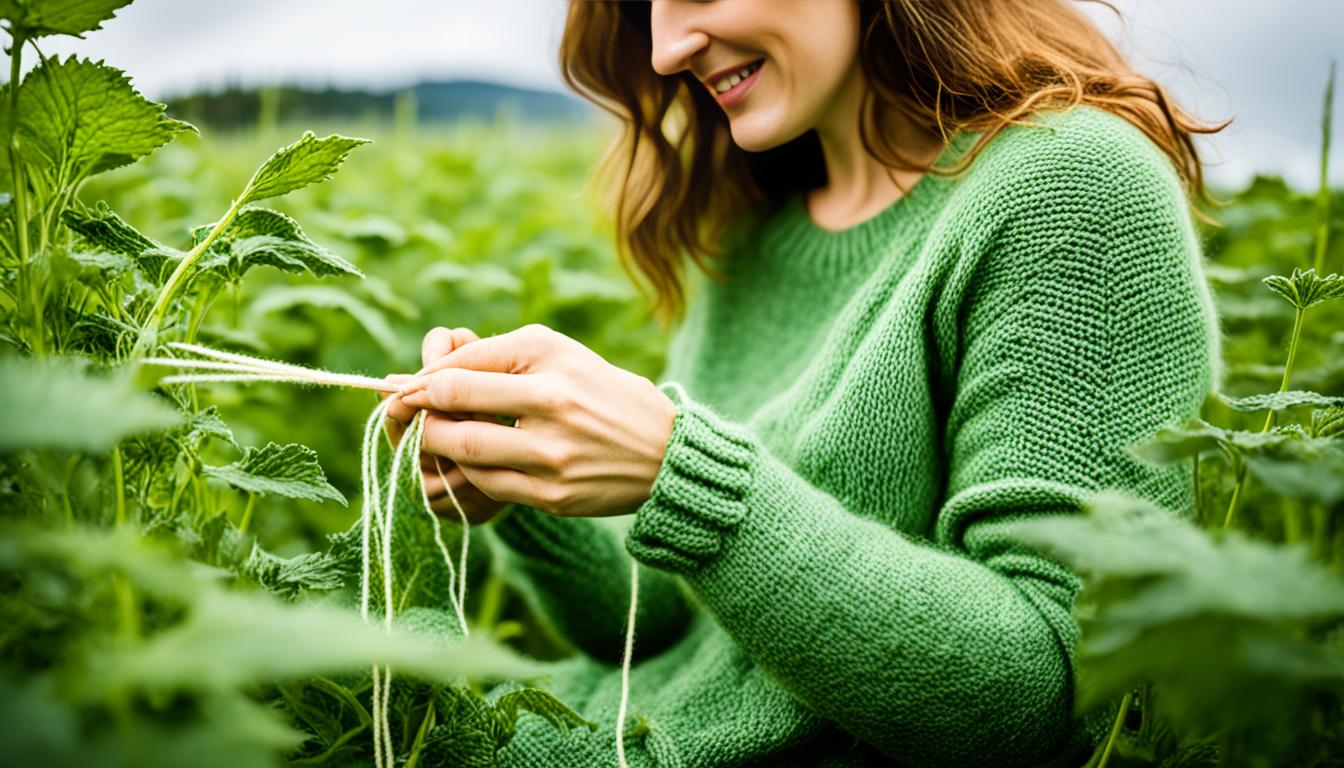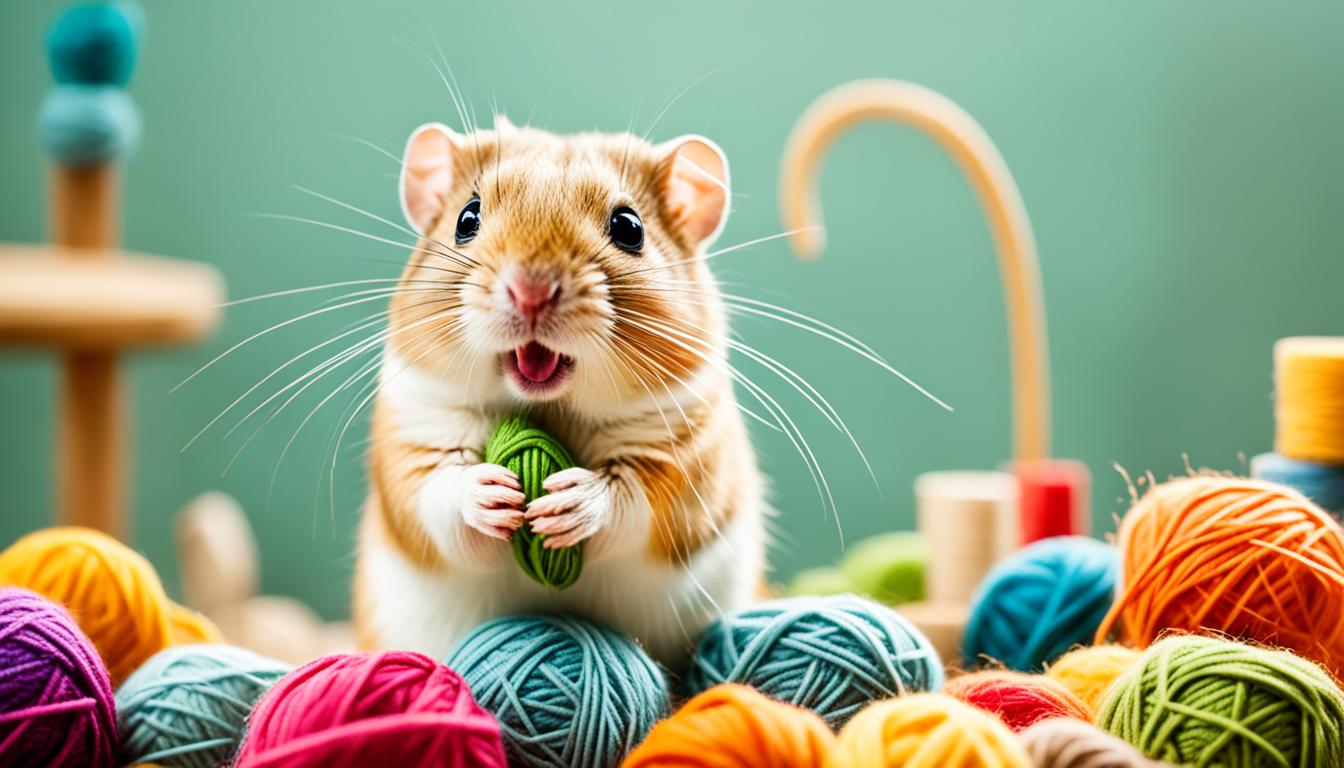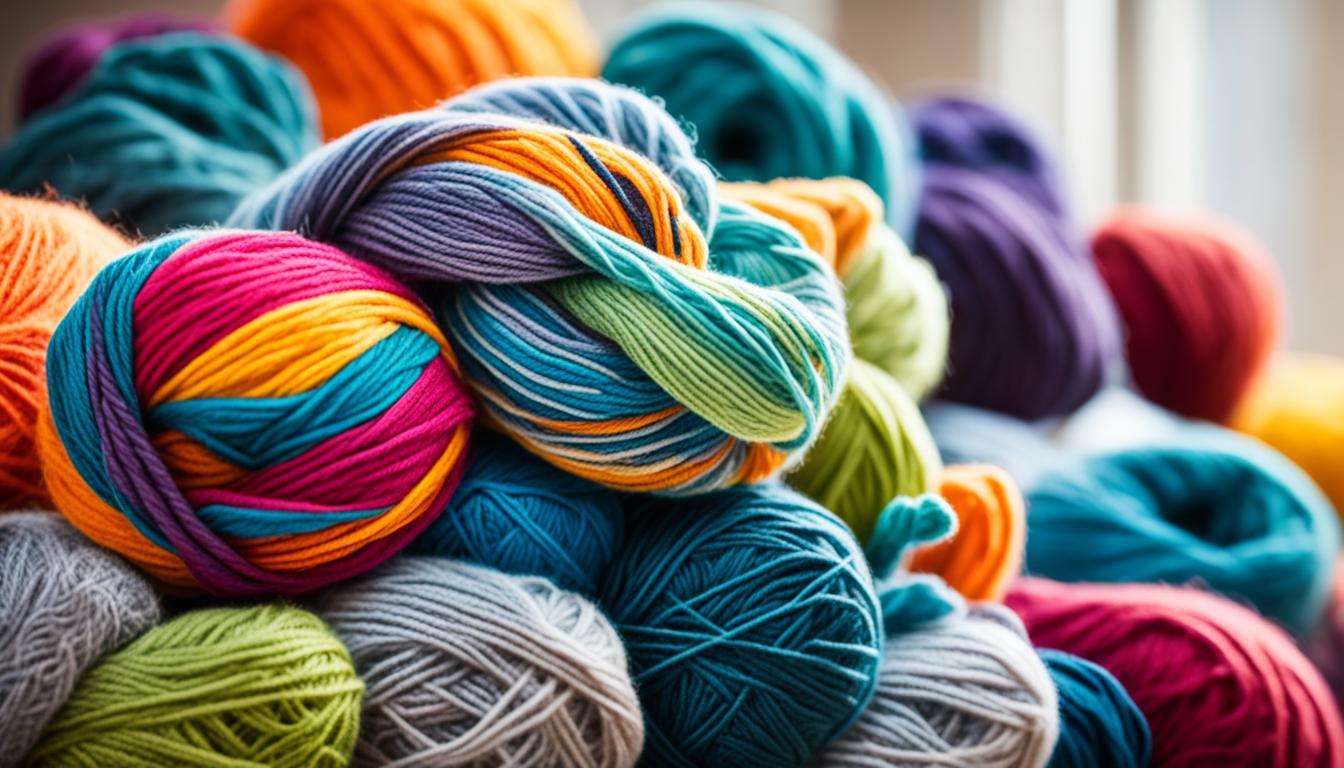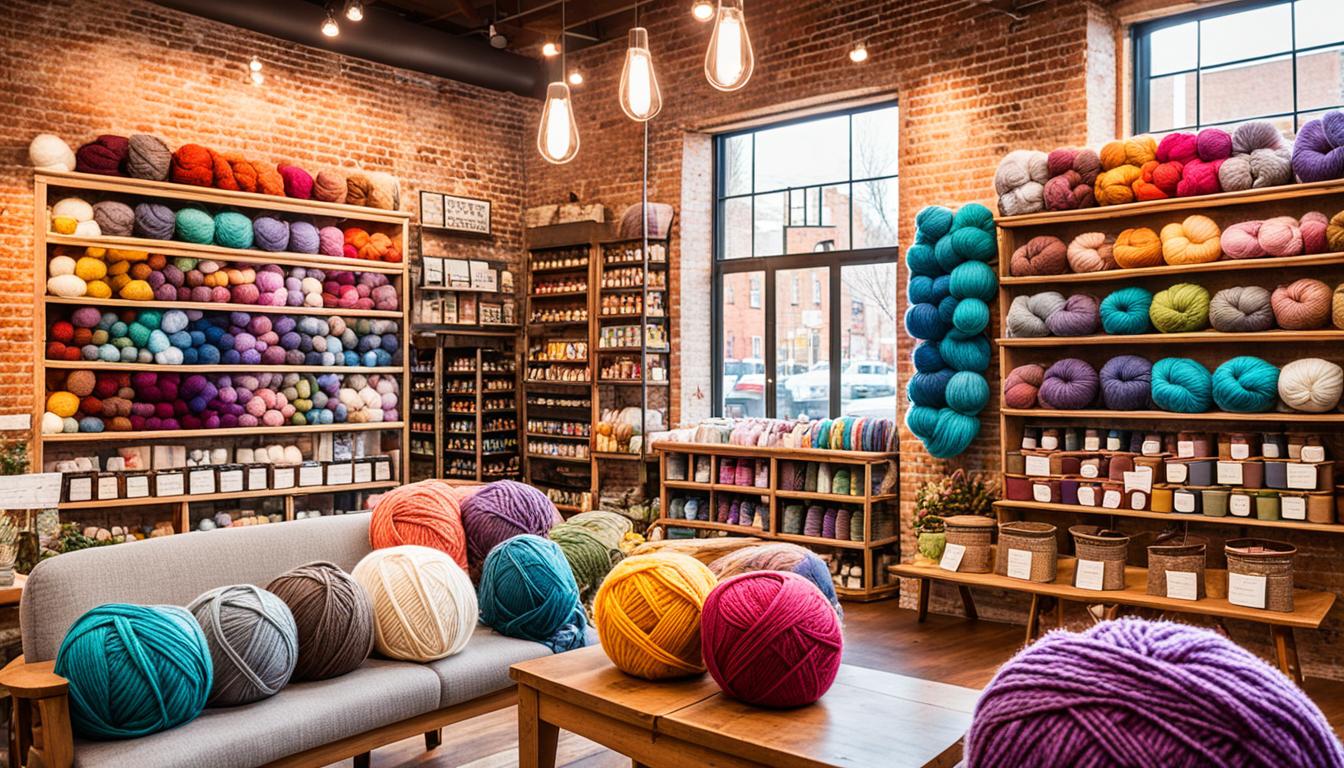Have you ever thought about whether there is a more environmentally friendly option to plastic fibers? Well, we may just have the solution for you. Introducing yarn nettle – an intriguing and sustainable material with a long history dating back thousands of years.
Nettle fibres, derived from the stalks of the nettle plant, have gained attention for their numerous benefits and diverse uses. From their biodegradability and reduced environmental impact to their strength and insulation properties, yarn nettle offers a greener option for textile enthusiasts.
In this article, we will delve into the world of yarn nettle, unveiling its fascinating background, the process of extracting its fibres, and its wide range of applications. Join us on this journey as we explore the sustainable potential of yarn nettle!
Key Takeaways:
- Yarn nettle is a sustainable alternative to plastic fibers.
- Nettle fibres are biodegradable and require less water and pesticides to produce compared to cotton.
- Nettle fibres have a rich history dating back thousands of years, with evidence of nettle cloth production in various regions around the world.
- Nettle fibres are known for their strength, insulation, and unique mottled appearance when blended with dyed wool.
- Choosing yarn nettle supports sustainable fashion and contributes to a greener future.
History of Nettle Fibres
Nettle fibres have a long and intriguing history, dating back to the Bronze Age when they were first used for clothing. Early records of nettle cloth production can be found in Voldtofte, Denmark. From there, nettle fibres spread throughout Europe and were widely utilized in countries such as Scandinavia, Poland, Germany, Russia, China, and Japan.
During this time, nettle fibres were highly valued for their durability and versatility. They were utilized in various types of clothing and textiles, ranging from everyday garments to heavy sailcloth. Nettle fabric offered a sustainable alternative to other natural fibres, such as flax and hemp.
“Nettle fibres were once known as the ‘Poor man’s Linen’ and were prized for their strength and practicality.”
However, with the rise of the cotton industry, nettle fibres saw a decline in popularity. Cotton became the dominant choice for clothing due to its availability and ease of cultivation. Nettle fibres eventually faded into obscurity, but they experienced a resurgence during World War I when scarcity and rationing drew attention to more sustainable textiles.
Today, nettle fibres are once again gaining recognition for their eco-friendly properties. As the fashion industry embraces sustainable practices, nettle cloth production is being revisited as a viable and environmentally conscious option. The history of nettle fibres serves as a testament to their resilience and enduring appeal.
Nettle Plants and Growing Process
When it comes to nettle fibre production, understanding the characteristics of nettle plants and their growing process is essential. There are three main species of nettle that are commonly used for fibre production, with the Himalayan Nettle being the most commercially grown variety.
Nettle plants are known for their versatility and resilience. They can thrive in a variety of environments, particularly fertile forest soils. This adaptability makes them an ideal choice for sustainable fibre production. Another advantage of nettle plants is that they require less water and pesticides compared to cotton, making them a more environmentally friendly option.
“Nettle plants are a sustainable alternative for fibre production due to their adaptability and lower resource requirements.”
Furthermore, nettle plants hold immense value beyond their fibre production capabilities. They have been used for centuries in various other contexts. For instance, nettle leaves can be brewed into tea, offering a refreshing and nourishing beverage. Nettle fibers are also a key ingredient in beer production, adding unique flavors and texture to the brew. Additionally, nettle plants have been used to make rennet, a crucial ingredient in cheese-making, and can serve as fodder for livestock.
Nettle Plants in Summary
- There are three main species of nettle used for fibre production.
- The Himalayan Nettle is the most commercially grown variety.
- Nettle plants can thrive in fertile forest soils.
- They require less water and pesticides compared to cotton.
- Nettle plants have multiple applications beyond fibre production, including tea, beer, rennet, and livestock fodder.
Now that we have explored the characteristics of nettle plants and their growing process, it’s time to delve into the extraction and processing of nettle fibres.
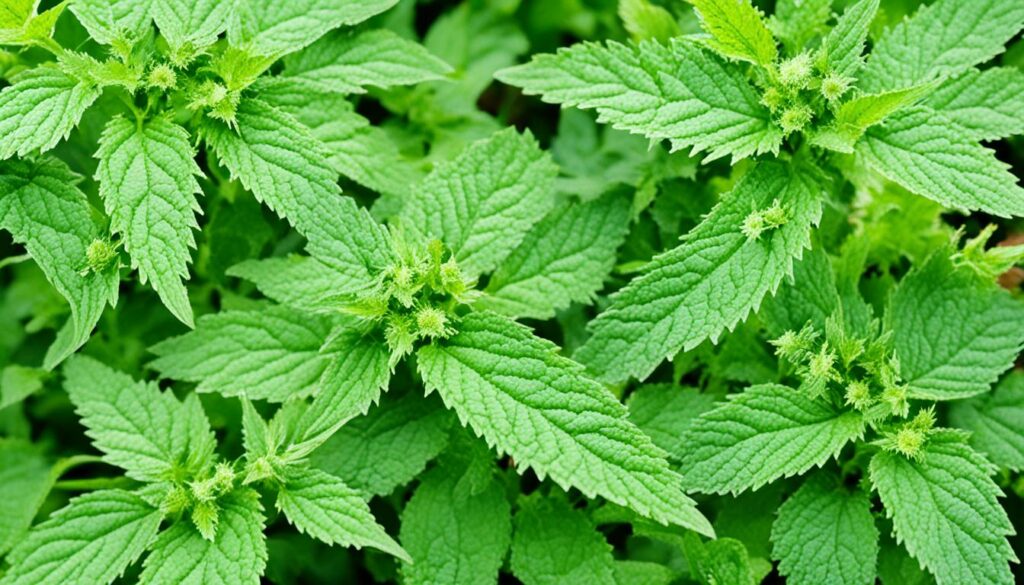
Extracting Nettle Fibres
Extracting nettle fibres is a meticulous process that involves several steps to ensure the quality and strength of the resulting fibres. Let’s take a closer look at how nettle fibres are extracted from the stem of the plant.
Harvesting and Preparing the Stems
The first step in extracting nettle fibres is harvesting mature nettle plants. Once harvested, the stems are carefully cut and stripped of their leaves to prepare them for further processing.
Note: Harvesting should be done with caution, as nettle plants have stinging hairs that can cause skin irritation. Protective clothing is recommended.
Removing the Bark and Stinging Hairs
After the stems have been prepared, the next step is to remove the outer bark. This is done by gently scraping the stems to expose the fibrous inner layer. Removing the bark reveals the nettle fibres hidden within.
The stems also contain thorn-like stinging hairs that need to be removed to ensure comfort and safety during the fibre extraction process. These hairs can be easily detached through careful rubbing or brushing.
Carding and Spinning
Once the bark and stinging hairs have been removed, the nettle fibres are ready for carding and spinning. Carding is the process of aligning and straightening the fibres using carding brushes or combs. This helps create a uniform and consistent strand of fibres.
After carding, the fibres are spun into a strong cord. This cord can be used for various purposes, such as making string, rope, or fishing nets. Additionally, nettle fibres are often blended with other natural fibres like cotton or wool to create yarns used in textile production.

Nettle Fibre Properties
Nettle fibres possess unique attributes that make them a remarkable choice for textile production. Their properties encompass strength, insulation, and a distinct appearance.
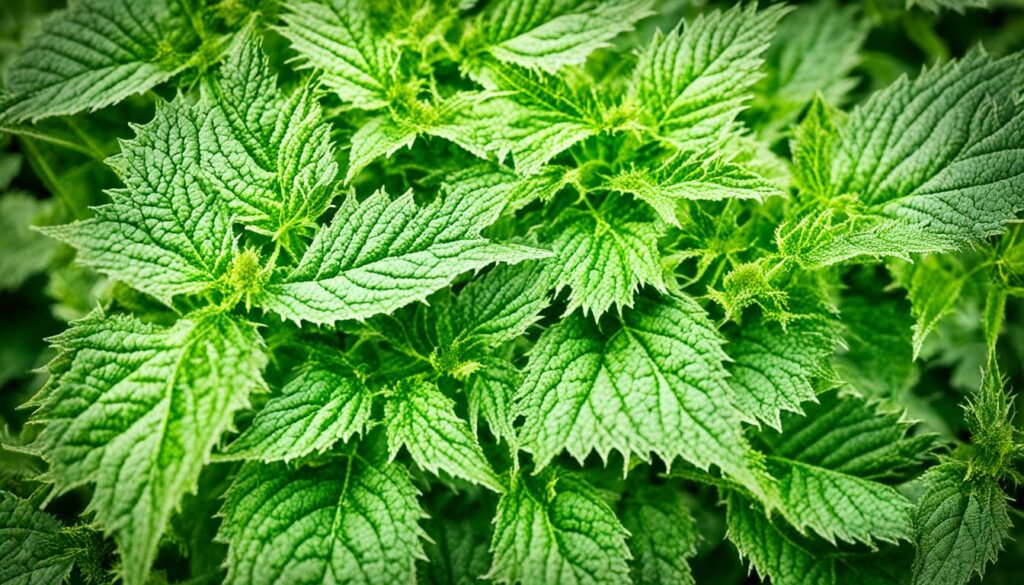
Why Nettle Fibres Stand Out
Let’s explore the notable properties that set nettle fibres apart:
- White, fine, and long: Nettle fibres exhibit a natural white hue and possess a fine, long structure, measuring up to 50mm. This characteristic contributes to their exceptional strength and durability.
- Hollow and insulating: The unique hollow structure of nettle fibres allows them to create insulation by trapping air inside. As a result, fabrics made with nettle fibres retain warmth while remaining breathable, making them ideal for various weather conditions.
- Mottled appearance: Unlike other fibres, dyes do not adhere easily to nettle fibres. As a result, when blended with dyed wool, nettle fibres create a slightly mottled appearance, adding visual interest to textiles.
A Visual Representation of Nettle Fibre Properties
To further illustrate the remarkable properties of nettle fibres, below is a table summarizing their key characteristics:
| Property | Description |
|---|---|
| Color | White |
| Structure | Fine and long (up to 50mm) |
| Insulation | Hollow structure for trapped air and warmth retention |
| Appearance | Slightly mottled when blended with dyed wool |
As demonstrated in the table, nettle fibres possess impressive qualities that make them desirable for textile enthusiasts seeking sustainable and unique materials.
The Future of Nettle Fibres
As concerns about the environmental impact of cotton production continue to grow, sustainable alternatives like nettle fibres are gaining attention in the textile industry. Innovations in spinning technologies and cross-breeding techniques are being explored to maximize the fibre yield from nettle plants, paving the way for a more sustainable future.
One notable initiative is STING, a British research project dedicated to developing nettle fibres for fabric and sustainable fashion. By harnessing the potential of nettle fibres, STING aims to contribute to the reduction of harmful environmental practices associated with traditional textile manufacturing.
Advancements in spinning technologies are enabling the production of high-quality nettle yarns that rival traditional fibres in strength and durability. This opens up exciting possibilities for the creation of sustainable and eco-friendly textiles.
Maximizing Fibre Yield
Researchers and farmers are working together to optimize nettle plant cultivation and increase fibre yield. Through cross-breeding and selective breeding, they aim to develop nettle plant varieties that are more productive and easier to harvest, without compromising the plant’s natural properties. This focus on maximizing fibre yield ensures that nettle fibres can be produced on a larger scale, thereby supporting widespread adoption.
Reducing Environmental Impact
Nettle fibres offer a more sustainable alternative to traditional textiles due to their minimal impact on the environment. Nettle plants require fewer resources, such as water and pesticides, to grow compared to cotton. Additionally, nettle fibres are biodegradable, contributing to the reduction of textile waste and its impact on landfill sites.
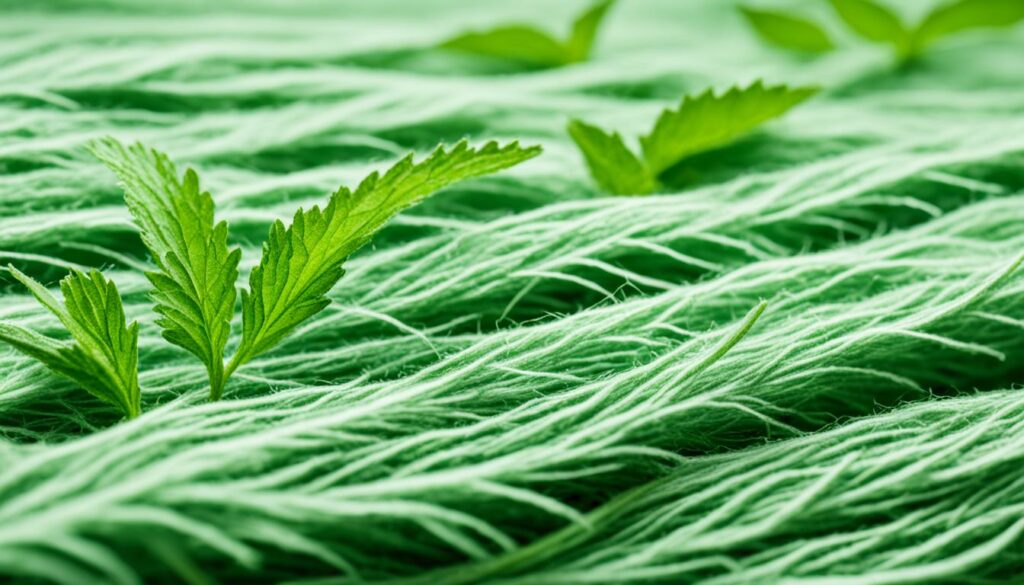
“The future of nettle fibres lies in their ability to provide sustainable solutions to the textile industry’s environmental challenges. By embracing nettle fibres, we can move towards a more sustainable and conscious approach to fashion.”
As the demand for sustainable and eco-friendly textiles continues to grow, the future of nettle fibres looks promising. With ongoing research and innovation, nettle fibres are expected to play a significant role in shaping the future of sustainable fashion. By supporting initiatives like STING and embracing nettle fibres, we can be part of the movement towards a more sustainable and ethical textile industry.
Nettle Fibres in Knitting
When it comes to knitting, nettle fibres have emerged as a sustainable and eco-friendly option. These fibres, when blended with wool, create strong sock yarns that offer both durability and environmental friendliness.
“Nettle fibres in knitting provide a unique combination of strength and sustainability.”
One popular choice among knitters is Onion’s Nettle Sock yarn, which is a blend of 70% wool and 30% nettle fibres. This yarn not only showcases the strength of nettle fibres but also offers a beautiful color palette to create stunning eco-conscious projects.
By incorporating nettle fibres into their knitting projects, makers can contribute to a more sustainable future while enjoying the benefits of a high-quality yarn.
Benefits of Nettle Fibres in Knitting
Knitting with nettle fibres offers several advantages beyond sustainability. Here are some key benefits:
- Durability: Nettle fibres add strength and longevity to knitted items. Socks made with nettle fibres are known for their resilience and ability to withstand frequent use and washing.
- Unique Texture: Nettle fibres introduce a subtle roughness to the fabric, adding character and interest to knitted projects.
- Insulation: The hollow structure of nettle fibres provides excellent insulation, keeping feet warm in cold weather without sacrificing breathability.
- Environmental Consciousness: By choosing nettle fibres in knitting, makers can actively participate in sustainable fashion practices and reduce their carbon footprint.
Whether it’s creating durable socks or exploring new knitting horizons, nettle fibres offer exciting possibilities for eco-conscious makers.
Knitting with Nettle Fibres – Creating Eco-Friendly Projects
The use of nettle fibres in knitting allows crafters to combine their love for knitting with their passion for environmentally friendly choices. The resulting projects not only showcase their creativity but also contribute to a greener world.
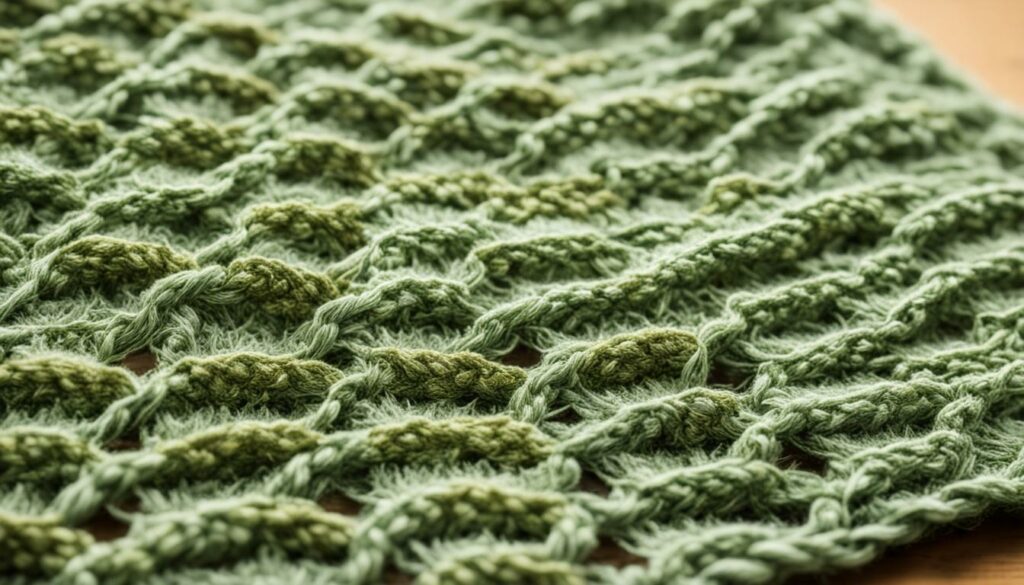
| Brand | Composition | Properties |
|---|---|---|
| Onion Nettle Sock Yarn | 70% wool, 30% nettle fibres | Strong, durable, eco-friendly |
| Nettleton Yarns | 50% nettle fibres, 50% organic wool | Soft, breathable, sustainable |
| EcoKnit | 100% nettle fibres | Naturally textured, biodegradable |
These brands offer a range of nettle yarns suitable for various knitting projects. With their unique properties and eco-friendly composition, nettle fibres in knitting are a choice that aligns with our values and supports a sustainable future.
Benefits of Nettle Fibres
Nettle fibres offer numerous benefits, making them an excellent choice for those seeking sustainable textiles. Their eco-friendliness and minimal environmental impact set them apart from synthetic fibres. Let’s explore the advantages of nettle fibres in more detail:
Eco-friendliness and Sustainability
Nettle fibres are biodegradable, meaning they naturally break down over time, reducing waste and pollution. Unlike synthetic fibres, nettle fibres do not contribute to the accumulation of microplastics in our ecosystems. By choosing nettle fibres, you are supporting a more sustainable and environmentally conscious textile industry.
“Nettle fibres offer eco-friendliness, minimal environmental impact, and excellent insulation properties.”
Resource Efficiency
The production of nettle fibres requires fewer resources compared to synthetic alternatives. Nettle plants require less water and pesticides, making them an ideal choice for conserving water and reducing the ecological footprint of textile production. By using nettle fibres, we can help ensure a more sustainable use of our planet’s resources.
Insulating Properties
Nettle fibres possess excellent insulating properties, providing warmth and comfort. The hollow structure of nettle fibres allows them to trap air, retaining heat while still allowing breathability. Fabrics made from nettle fibres can help regulate body temperature, keeping you comfortable in various weather conditions.
“Nettle fibres offer resource efficiency, excellent insulation properties, and contribute to a greener future.”
Unique Fabric Textures
Nettle fibres add a distinctive texture to fabrics when blended with other materials like wool. The mottled appearance created by nettle fibres adds visual interest and depth to garments. By incorporating nettle fibres into your textile choices, you can create unique and eye-catching pieces.
img src=”https://seowriting.ai/32_6.png” alt=”sustainable textile choice”>
| Fiber | Eco-friendliness | Resource Efficiency | Insulating Properties | Unique Fabric Textures |
|---|---|---|---|---|
| Nettle Fibres | ✔️ | ✔️ | ✔️ | ✔️ |
| Synthetic Fibres | ❌ | ❌ | ❌ | ❌ |
| Cotton | ❌ | ❌ | ❌ | ❌ |
Disclaimer: The above table provides a general comparison of different fibres based on eco-friendliness, resource efficiency, insulating properties, and fabric textures. The specific characteristics may vary depending on the production methods and blend ratios used.
Nettle Yarn Varieties and Production
When it comes to nettle yarn, there are various varieties available, each with its own unique characteristics. Nettle yarn can be found in the form of hanks and skeins, providing options for different knitting and crochet projects.
To produce nettle yarn, the first step is harvesting nettle fibers. These fibers are carefully hand-harvested from nettle plants, ensuring their quality and sustainability. The next step involves the natural processing of these fibers using water and wood ash, also known as lye. This traditional method helps to enhance the durability and texture of the yarn, resulting in a high-quality product.
Nettle yarn naturally possesses a range of colors, which can vary from light grey/beige to brown/beige. This natural color palette adds an organic and earthy touch to your knitting projects, reflecting the sustainable and eco-friendly nature of nettle yarn.
The production of nettle yarn not only offers a unique textile option but also supports ethical practices and empowers local communities. By choosing nettle yarn, you are contributing to a more sustainable and responsible fashion industry, promoting fair trade and eco-conscious choices.
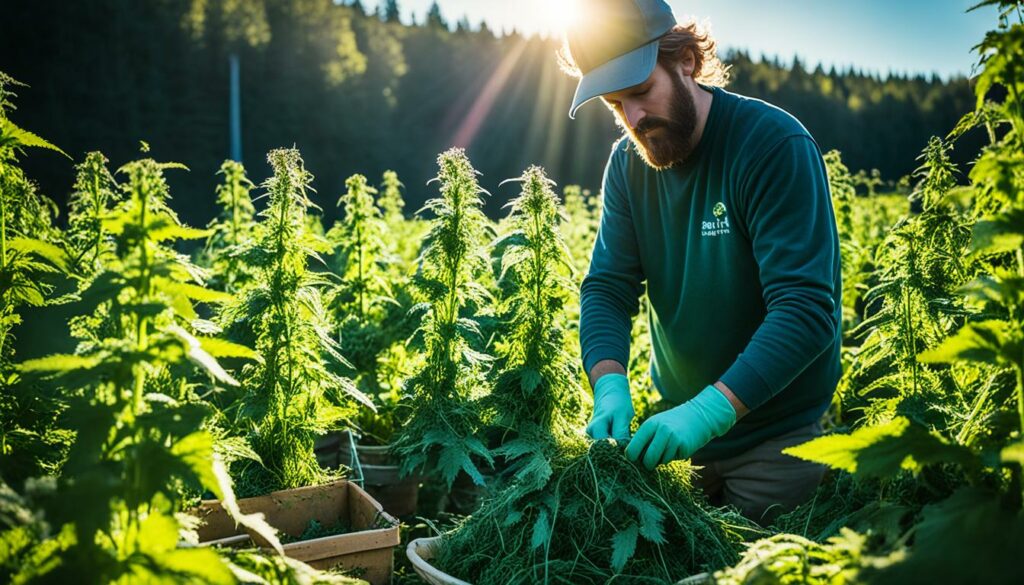
Comparative Table: Nettle Yarn Varieties
| Variety | Characteristics |
|---|---|
| Natural Nettle Yarn | Sustainably produced, ranges in color from light grey/beige to brown/beige, strong and durable |
| Blended Nettle Yarn | Mix of nettle fibers with other natural fibers such as wool or cotton, offering unique textures and qualities |
| Hand-Dyed Nettle Yarn | Nettle yarn dyed using natural plant-based dyes, creating vibrant and eco-friendly color options |
Whether you choose natural nettle yarn, blended varieties, or hand-dyed options, incorporating nettle yarn into your projects brings a touch of sustainability and craftsmanship.
Nettle Yarn Uses
Nettle yarn is a versatile material that can be used in various crafts, including knitting, crochet, weaving, and sewing. Its unique properties make it a preferred choice for eco-conscious makers looking to create sustainable and stylish garments and accessories.
When it comes to knitting, nettle yarn offers strength and durability, making it suitable for a range of projects. While it has a medium-sized yarn thickness, its semi-rough texture and occasional stiffness may not be ideal for intricate or delicate work.
However, the rustic nature of nettle yarn lends itself well to projects that require durability and structure. Knitters can use nettle yarn to create cozy sweaters, cardigans, hats, scarves, and even bags. The natural mottled appearance of nettle yarn, especially when blended with dyed wool, adds a unique touch to these creations.
Additionally, nettle yarn’s strength makes it an excellent choice for knitting socks. The combination of nettle fibers with wool creates sock yarns that are both sturdy and environmentally friendly. So, whether you’re knitting a pair of warm winter socks or lightweight summer socks, nettle yarn can provide the durability and comfort you need.
“Nettle yarn’s rustic texture and durability make it a fantastic choice for knitting projects that require strength and structure.”
Furthermore, nettle yarn can be used in other crafts beyond knitting. Crocheters can create unique and textured garments, such as shawls, ponchos, and bags, using nettle yarn. Weavers can incorporate nettle yarn into their tapestries, giving them an earthy and sustainable touch. Seamstresses and tailors can utilize nettle yarn in sewing projects, adding strength and character to their creations.
To get started with nettle yarn projects, you can find a variety of nettle yarn options on the market. One popular choice is Onion’s Nettle Sock yarn, which blends 70% wool with 30% nettle fibers to strike the perfect balance between strength and softness.
Benefits of Using Nettle Yarn:
- Strength and durability for long-lasting creations.
- Unique rustic texture and mottled appearance.
- Environmentally friendly and sustainable choice.
- Provides warmth and insulation in knitted items.
- Expands the range of eco-friendly crafting options.
With nettle yarn, you can showcase your creativity while making a positive impact on the environment. Explore the world of nettle yarn and discover the endless possibilities it offers for your knitting and crafting endeavors.
| Nettle Yarn Uses | Description |
|---|---|
| Knitting | Provides strength and durability for various knitting projects, including sweaters, hats, scarves, and socks. |
| Crochet | Creates unique and textured garments, such as shawls, ponchos, and bags. |
| Weaving | Offers an earthy and sustainable touch to tapestries and woven creations. |
| Sewing | Adds strength and character to sewn items, expanding the range of eco-friendly crafting options. |
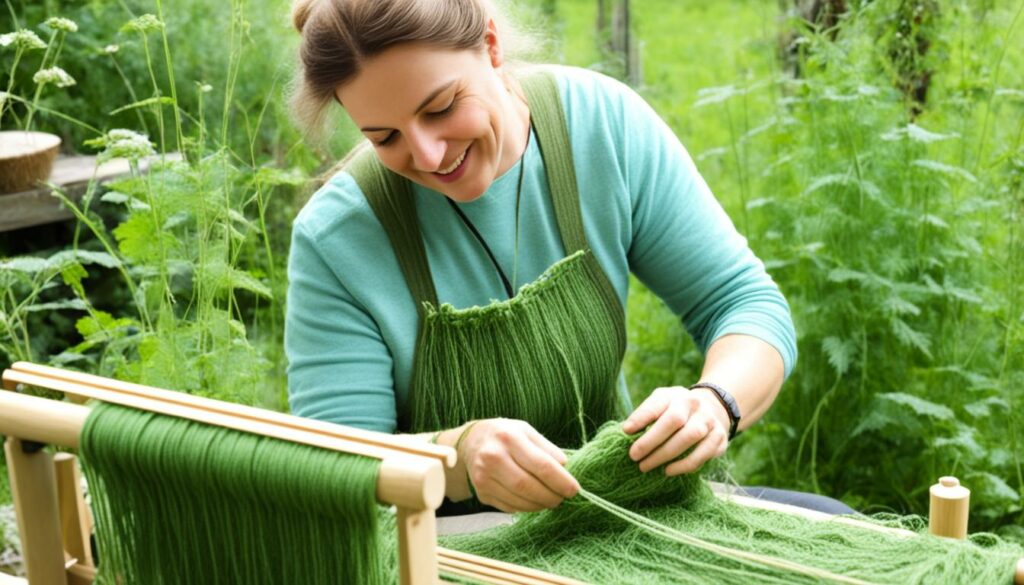
Nettle Yarn in History
Nettle yarn has a rich history dating back centuries, where it played a significant role in Europe as a versatile and durable fiber. Known as the “Poor man’s Linen,” nettle yarn was highly valued for its affordability and practicality.
In the past, nettle yarn was used for various applications, ranging from heavy sailcloth to fine table linen. Its strength and durability made it a popular choice for everyday items like bedsheets and tablecloths.
“Nettle yarn rivaled flax and hemp as a staple fiber, offering a sustainable and accessible alternative for textile production. Its versatility and practicality made it an indispensable resource for European communities.”
Despite its popularity, the demand for nettle yarn declined over time with the rise of other natural and synthetic fibers. However, its historical significance highlights its unique qualities and demonstrates how it has stood the test of time.
Nettle Yarn Uses in the Past
In the past, nettle yarn was cherished for its resilience and strength. Its applications were diverse and included:
- Heavy sailcloth: Nettle yarn’s durability made it suitable for crafting robust sailcloth that could withstand the demanding conditions of maritime exploration.
- Table linen: Nettle yarn’s fine texture and strength made it an excellent choice for creating elegant tablecloths that could be passed down through generations.
- Bedsheets: The strength of nettle yarn made it ideal for weaving durable bedsheets, ensuring they could withstand repeated use and washing.
- Clothing: Nettle yarn was also used in the production of clothing, such as sturdy workwear and durable outer garments.
The versatility of nettle yarn in the past showcases its adaptability and reliability as a textile material, cementing its place in history as a valued resource for various purposes.
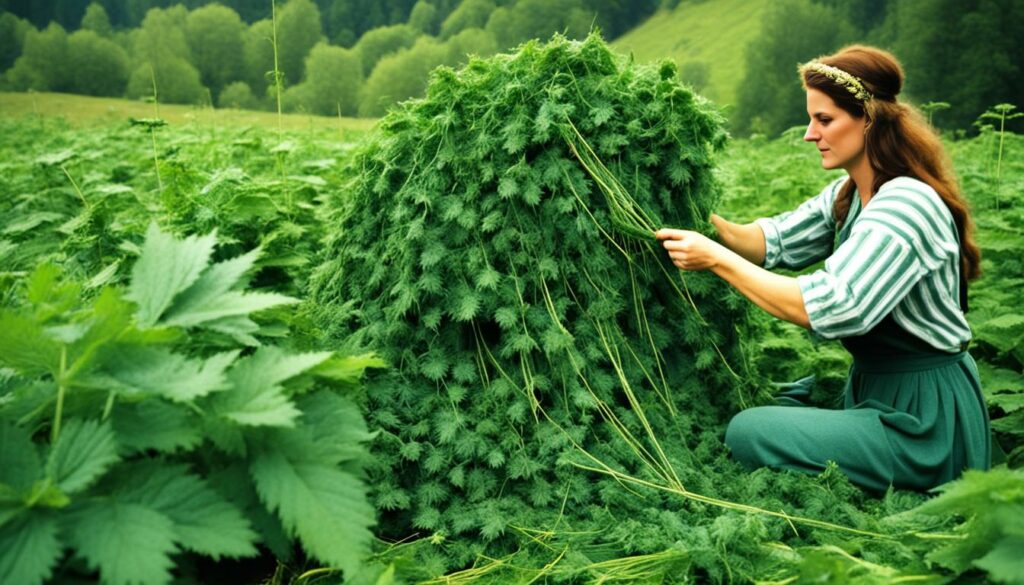
Nettle yarn’s historical significance highlights its enduring qualities that continue to capture the interest of textile enthusiasts today.
Conclusion
In conclusion, yarn nettle is a remarkable choice for textile enthusiasts who prioritize sustainability and eco-friendliness. With its rich history and versatile properties, it opens up endless possibilities for the future of fashion. By embracing nettle fibres and yarns, we can actively contribute to a more conscious and environmentally-friendly approach to clothing production.
Yarn nettle offers a multitude of benefits that make it an exciting material for textile enthusiasts. Not only is it biodegradable and requires fewer resources to process compared to synthetic fibers, but it also possesses excellent insulating properties. This makes it an ideal choice for garments that provide warmth while remaining breathable, resulting in comfortable and sustainable clothing options.
By making a conscious choice to incorporate nettle fibers and yarns into our projects, we can support sustainable fashion and advocate for a greener future. Nettle yarn allows us to create unique and eco-friendly garments and accessories, showcasing our commitment to both individual style and global environmental responsibility. Let’s embrace yarn nettle and make a positive impact in the world of fashion and beyond.
